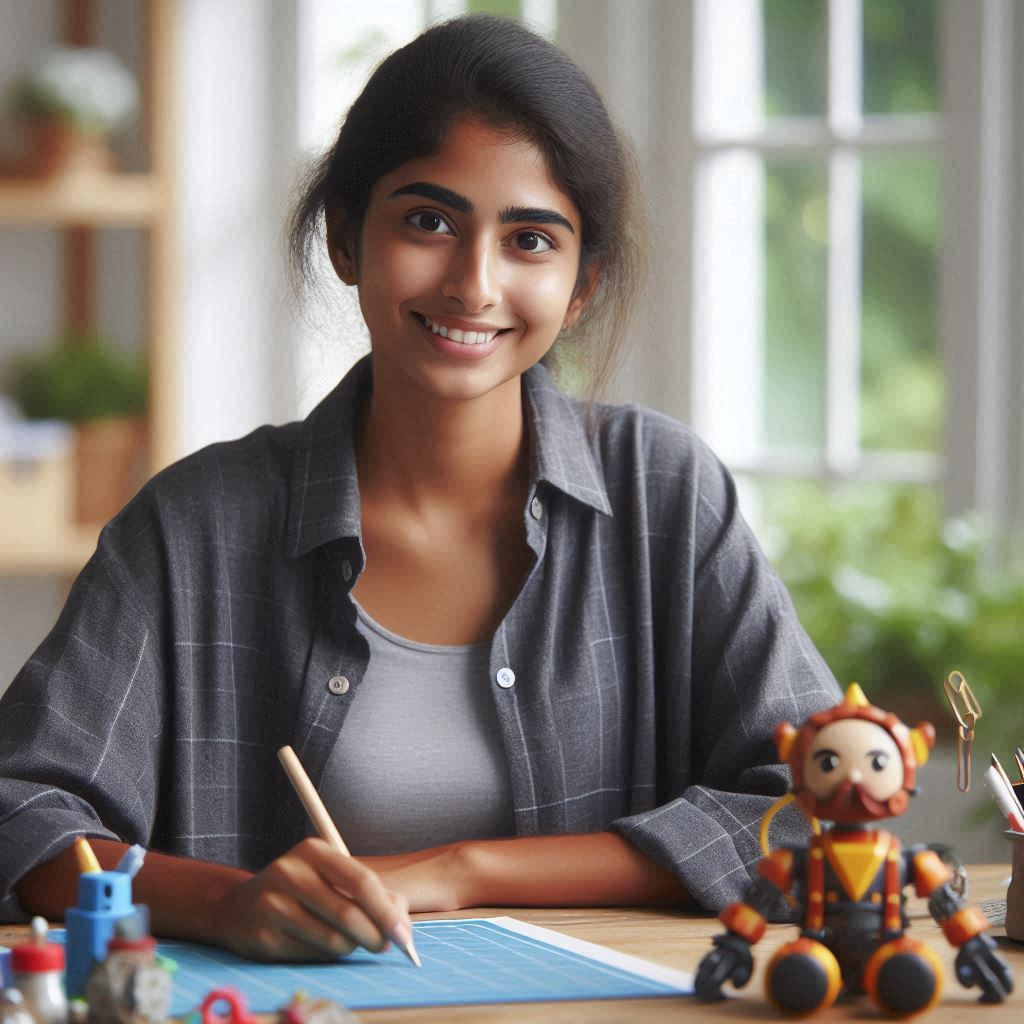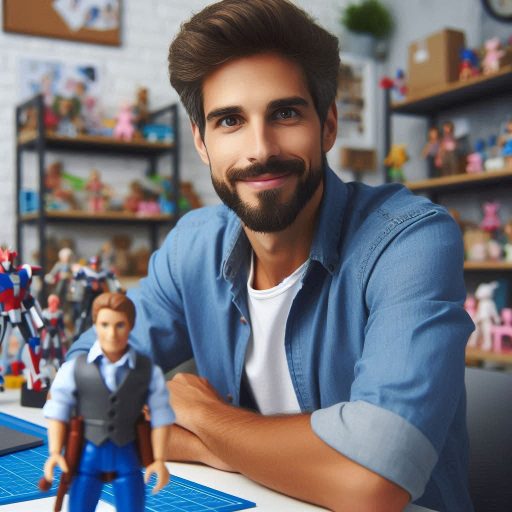Introduction
Creating a successful toy design portfolio is crucial for aspiring designers to showcase their skills and creativity.
Toy design portfolios are collections of work that highlight a designer’s projects, concepts, and artistic abilities within the toy industry.
A strong portfolio is essential for attracting potential employers, clients, and collaborators in the competitive toy design field.
This blog post will provide valuable tips and strategies for creating a standout toy design portfolio that effectively showcases your talents.
Research and gather inspiration
When starting your toy design portfolio, it’s crucial to begin by researching and gathering inspiration from various sources.
Look at different types of toys, materials, and styles to get a sense of what resonates with you.
You can visit toy stores, browse online platforms, attend toy fairs, and even look at art and design books for inspiration.
Study trends in the toy design industry
To create a successful toy design portfolio, you need to stay updated on the latest trends in the industry.
Follow toy design blogs, websites, and social media accounts to see what’s popular and what’s resonating with consumers.
By staying informed, you can ensure that your portfolio is relevant and appealing to potential clients.
Look at successful toy designers’ portfolios for ideas
One of the best ways to improve your portfolio is by looking at what successful toy designers are doing.
Study their portfolios to see how they present their work, showcase their skills, and communicate their unique style.
Take note of elements that stand out to you and consider incorporating similar techniques into your own portfolio.
Identify your unique style and niche within the market
To stand out in the competitive toy design industry, it’s essential to identify your unique style and niche within the market.
Consider what sets you apart from other designers and how you can position yourself as a specialist in a particular area.
Whether it’s a specific type of toy, material, or design aesthetic, make sure to highlight what makes your work distinctive in your portfolio.
In essence, creating a successful toy design portfolio requires thorough research, inspiration gathering, trend analysis, and a clear understanding of your unique style and niche within the market.
By following these tips and incorporating them into your portfolio, you can increase your chances of standing out and attracting potential clients and opportunities in the industry.
Read: Famous Toy Designers You Should Know About
Creating a Cohesive and Visually Appealing Portfolio
When designing your toy design portfolio, it’s important to ensure that it has a cohesive and visually appealing look.
Transform Your Career Today
Unlock a personalized career strategy that drives real results. Get tailored advice and a roadmap designed just for you.
Start NowChoose a consistent color scheme, fonts, and layout to tie everything together.
Including a Variety of Projects Showcasing Your Skills
Include a diverse range of toy design projects in your portfolio to demonstrate your versatility and expertise.
Show different styles, materials, and techniques to showcase the breadth of your skills.
Designing a Professional and Easy-to-Navigate Layout
Make sure your portfolio is easy to navigate and showcases your work effectively.
Use clear categories, labels, and navigation buttons to guide viewers through your projects seamlessly.
Highlighting Your Best Work and Attention to Detail
Be selective when choosing which projects to include in your portfolio.
Highlight your best work that demonstrates your creativity, technical skills, and attention to detail.
Quality over quantity is key.
Read: Must-Have Tools for Toy Designers
Write compelling project descriptions
When describing your projects, focus on the unique features and benefits of each design.
Highlight the challenges you faced and how you overcame them in the process.
Include specific details such as materials used, dimensions, and any special techniques employed.
Use descriptive language to create a vivid picture of your work in the reader’s mind.
Clearly explain your design process and inspiration
- Walk the reader through your thought process from ideation to final product.
- Discuss where you drew inspiration from, whether it be nature, art, or everyday objects.
- Explain how you approached problem-solving and iteration during the design phase.
- Show how your process is methodical and well-thought-out.
Use storytelling to engage potential clients or employers
- Create a narrative around each project that captivates the reader’s attention.
- Share personal anecdotes or insights that showcase your passion for toy design.
- Make the reader feel connected to your work by weaving a compelling story.
- Demonstrate your enthusiasm and creativity through engaging storytelling.
Showcase your creativity and problem-solving abilities
- Highlight projects that demonstrate your ability to think outside the box.
- Include designs that showcase your innovation and originality in toy design.
- Illustrate how you approached challenges and found creative solutions.
- Provide examples of how your designs have pushed boundaries and exceeded expectations.
Read: From Concept to Creation: Toy Design Process

Include mockups and prototypes
Creating a standout toy design portfolio requires careful attention to detail and an understanding of what potential employers are looking for.
By including mockups and prototypes in your portfolio, you can demonstrate your ability to bring ideas to life and showcase your design process effectively.
Mockups and Prototypes
- Include mockups: Create realistic representations of your design concepts to show their potential.
- Develop prototypes: Take your designs further by creating physical or digital models to demonstrate functionality.
Bringing Ideas to Life
- Show your creativity: Use your portfolio to showcase innovative and original toy designs.
- Highlight problem-solving skills: Demonstrate how you address challenges in your design process.
Different Stages of the Design Process
- Concept development: Show initial sketches and brainstorming ideas to illustrate your creative process.
- Iteration: Display how your designs evolve through feedback and multiple iterations.
Visual Presentation
- Use high-quality images: Make sure your portfolio is visually appealing with clear, professional images.
- Consider 3D renderings: Create detailed renderings to give a realistic representation of your designs.
Standout Projects
- Focus on quality over quantity: Include a selection of your best work rather than overwhelming your portfolio with mediocre designs.
- Showcase a range of skills: Include projects that demonstrate different aspects of toy design, from concept development to final presentation.
Collaborative Projects
- Highlight teamwork: If you’ve worked on projects with other designers or departments, showcase your ability to collaborate effectively.
- Demonstrate communication: Show how you effectively convey your ideas and receive feedback from others.
Client Projects
- Include real-world examples: Show projects you’ve completed for clients to demonstrate your ability to work within constraints and meet deadlines.
- Highlight successful outcomes: Showcase how your designs have met or exceeded client expectations.
Industry Relevance
- Stay current: Include projects that reflect trends in the toy design industry to show your understanding of market demands.
- Show versatility: Demonstrate your ability to design for different target audiences and product categories.
In general, a successful toy design portfolio should effectively showcase your creativity, problem-solving skills, and ability to bring ideas to life.
By including mockups, prototypes, and a variety of projects that demonstrate different stages of the design process, you can create a compelling portfolio that sets you apart from other designers in the industry.
Remember to use high-quality images and thoughtful presentation to enhance your portfolio and make a lasting impression on potential employers.
Read: How to Break into the Toy Design Industry
Transform Your Career Today
Unlock a personalized career strategy that drives real results. Get tailored advice and a roadmap designed just for you.
Start NowLearn More: Working with Precious Metals in Jewelry Design
Seek feedback from peers and industry professionals
One of the most effective ways to improve your toy design portfolio is to seek feedback from peers and industry professionals.
By sharing your work with others in the field, you can gain valuable insights and perspectives that can help you identify areas for improvement.
Constructive criticism is essential for growth, so be open to feedback and use it to refine your portfolio.
Join Online Design Communities for Critique and Advice
In addition to seeking feedback from individuals you know personally, consider joining online design communities dedicated to toy design.
These communities provide a platform for designers to share their work, receive critique, and exchange ideas with others in the field.
By actively participating in these groups, you can gain valuable insights, learn from others, and improve your portfolio.
Attend Design Events and Conferences to Network and Showcase Your Work
Networking is a crucial aspect of advancing your career in toy design.
Attend design events, conferences, and industry gatherings to connect with potential employers, clients, and other professionals in the field.
These events offer opportunities to showcase your portfolio, receive feedback, and make valuable connections that can lead to exciting career opportunities.
Remember to bring business cards and be prepared to talk about your work in a compelling and engaging way.
Use Feedback to Improve and Refine Your Portfolio
After receiving feedback from peers, industry professionals, and online communities, it is essential to use this information to improve and refine your toy design portfolio.
Analyze the critiques you have received, identify common themes or areas for improvement, and make necessary adjustments to enhance your portfolio.
By continually seeking feedback and iterating on your work, you can create a portfolio that effectively showcases your skills, creativity, and passion for toy design.
Update your portfolio regularly
Add new projects and remove outdated work
It is essential to keep your toy design portfolio updated to showcase your latest work.
Adding new projects shows potential clients and employers that you are actively working and creating.
Remove outdated work to keep your portfolio fresh and relevant to the current industry standards.
Keep up with industry trends
Staying informed about the latest trends in toy design is crucial for success.
By incorporating new techniques, you demonstrate your adaptability and willingness to evolve with the industry.
Showing that you are aware of and can implement current trends will make you more attractive to potential clients.
Transform Your Career Today
Unlock a personalized career strategy that drives real results. Get tailored advice and a roadmap designed just for you.
Start NowShow growth and development
Displaying growth and development in your skills and style is key to a successful toy design portfolio.
Include a variety of projects that showcase your range and progression as a designer.
Clients want to see that you are continually improving and pushing yourself creatively.
By following these tips and regularly updating your toy design portfolio, you can set yourself up for success in the competitive field of toy design.
Conclusion
A strong toy design portfolio is crucial for success in the competitive industry.
It showcases your skills, creativity, and unique design style.
Without a compelling portfolio, it may be challenging to stand out.
Start building your portfolio today by selecting your best projects.
Focus on quality over quantity to make a lasting impression.
Remember to update and refine your portfolio regularly to stay relevant.
Continuously seek feedback from peers or mentors to improve.
Networking and attending industry events can also boost your visibility.
Take action now and invest in your toy design portfolio.
Your portfolio is a reflection of your talent and passion.
It can open doors to exciting opportunities and collaborations.
Stay committed to building a standout portfolio that sets you apart.
Believe in your abilities and let your creativity shine through.
Now is the time to start building your dream toy design portfolio.
Don’t wait, take that first step towards your design career today.
[E-Books for Sale]
The Big Book of 500 High-Paying Jobs in America: Unlock Your Earning Potential
$19.99 • 500 High-Paying Jobs • 330 pages
Explore 500 high-paying jobs in America and learn how to boost your career, earn more, and achieve success!
See All 500 High-Paying Jobs of this E-Book
1001 Professions Without a Degree: High-Paying American Jobs You Can Start Now
$19.99 • 1001 Professions Without a Degree • 174 pages
Discover 1001 high-paying jobs without a degree! Unlock career tips, skills, and success strategies for just $19.99!




